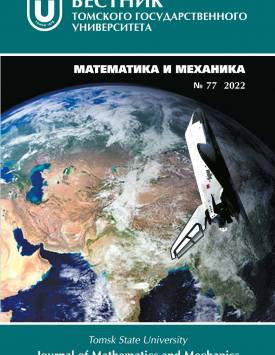Analysis of a dynamic structure of secular resonances in circumlunar orbital space
When developing new circumlunar satellite systems for various purposes, it is necessary to know the dynamic features of various regions of circumlunar space. It is noted that one of the main features of the dynamics of artificial Moon satellites (AMS) is the increase in the eccentricity of their orbits. It is known that such orbital evolution of objects can be caused by resonant perturbations. In this regard, the purpose of this paper is to study the influence of secular and half-secular resonances occurring on the AMS. The results are obtained by means of the processing of data from an extensive numerical experiment to study the orbital evolution of the uniformly distributed circumlunar objects moving in the range of large semi-axes from 1911.8 to 26070 km and with inclinations from 0 to 180°. The study of the influence of secular and half-secular resonances on the orbital evolution of the AMS is carried out using numerical and analytical techniques. Both techniques have advantages and disadvantages and are used in the study. Maps of secular and half-secular resonances are of great practical importance. They clearly demonstrate the areas of influence of secular resonances on the orbital evolution of circumlunar objects depending on the initial values of the semimajor axis and inclination of the orbits of objects. The analysis of each particular resonance consists in the revealing of a resonant characteristic type, which is determined by the nature of the change in a critical argument: libration - stable resonance, libration/circulation - unstable resonance, and circulation - no resonance. To estimate the whole range of the influence of resonances on the AMS dynamics, maps of their overlaps are built. The maps allow one to determine areas with significant influence of the resonances on the orbital evolution of circumlunar objects. The obtained results show that the reason for a large increase in the eccentricity in a vast area of circumlunar orbital space is the presence of the stable apsidal resonance of the Kozai-Lidov type.
Keywords
circumlunar space,
artificial satellites of the Moon,
dynamic structure,
secular and half-secular resonances,
resonance mapsAuthors
| Popandopulo Nikita A. | Tomsk State University | nikas.popandopulos.com |
| Aleksandrova Anna G. | Tomsk State University | aleksann@sibmail.com; aleksandrovaannag@mail.ru |
| Bordovitsyna Tat’yana V. | Tomsk State University | tvbord@sibmail.com |
Всего: 3
References
Попандопуло Н.А., Александрова А.Г., Томилова И.В., Авдюшев В.А., Бордовицына Т.В. Численное моделирование динамики искусственных спутников Луны // Астрономический вестник. 2022. Т. 56, № 4. (В печати).
Cook G.E. Luni-Solar Perturbations of the Orbit of an Earth Satellite // Geophys. J. 1962. V. 6, No. 3. P. 271-291. doi: 10.1111/j.1365-246X.1962.tb00351.x
Breiter S. Lunisolar apsidal resonances at lowsatellite orbits // Celest. Mech. Dyn. Astr. 1999. V. 74. P. 253-274. doi: 10.1023/A:1008379908163
Breiter S. Lunisolar resonances revisited // Celest. Mech. Dyn. Astr. 2001. V. 81. P. 81-91. doi: 10.1023/A:1013363221377
Chao C., Gick R. Long-term evolution of navigation satellite orbits // Adv. Space Res. 2004. V. 34. P. 1221-1226. doi: 10.1016/j.asr.2003.01.021
Rossi A. Resonant dynamics of Medium Earth Orbits: space debris // Celest. Mech. Dyn. Astr. 2008. V. 100. P. 267-286. doi: 10.1007/s10569-008-9121-1
Прохоренко В.И. Геометрическое исследование решений ограниченной круговой дву кратно осредненной задачи трех тел // Космические исследования. 2001. Т. 39, № 6. С. 622-633.
Wang Y., Gurfil P. The Role of Solar Apsidal Resonance in the Evolution of Geostationary Transfer Orbits // Advances in Space Research. 2017. V. 1 (8). P. 2101-2116. doi: 10.1016/j.asr.2017.01.038
Попандопуло Н.А., Александрова А.Г., Бордовицына Т.В. К обоснованию численно аналитической методики выявления вековых резонансов // Известия вузов. Физика. 2022. Т. 62. (В печати).
Бордовицына Т.В., Томилова И.В., Чувашов И.Н. Влияние вековых резонансов на долговременную орбитальную эволюции неуправляемых объектов спутниковых радионавигационных систем в области МЕО // Астрономический вестник. 2012. Т. 46, № 5. C. 356-368.
Александрова А.Г., Бордовицына Т.В, Попандопуло Н.А., Томилова И.В. Новый подход к вычислению вековых частот в динамике околоземных объектов на орбитах с большими эксцентриситетами // Известия вузов. Физика. 2020. Т. 63, № 1 (745). С. 57-62. doi: 10.17223/00213411/63/1/57
Дубошин Г.Н. Небесная механика. Основные задачи и методы. М. : Физматгиз, 1963. 586 с.
Авдюшев В.А. Новый коллокационный интегратор для решения задач динамики. I. Теоретические основы // Известия вузов. Физика. 2020. Т 63, № 11. С. 131-140. doi: 10.17223/00213411/63/11/131
Авдюшев В.А. Интегратор Гаусса-Эверхарта // Вычислительные технологии. 2010. Т. 15, № 4. С. 31-46.
Song Y.J., Park S.Y., Kim H.D., Sim E.S. Development of precise lunar orbit propagator and lunar polar orbiter's lifetime analysis // Journal of Astronomy and Space Sciences. 2010. V. 27 (2). P. 97-106. doi: 10.5140/JASS.2010.27.2.097
Gupta S., Sharma R. Effect of Altitude, Right Ascension of Ascending Node and Inclination on Lifetime of Circular Lunar Orbits // International Journal of Astronomy and Astrophysics. 2011. V. 1 (3). P. 155-163. doi: 10.4236/ijaa.2011.13020
Folkner W.M., Park R.S. Planetary ephemeris DE438 for Juno : Technical Report IOM392R-18-004. Pasadena, CA : Jet Propulsion Laboratory, 2018.
Александрова А.Г., Блинкова Е.В., Бордовицына Т.В., Попандопуло НА., Томилова И.В. Вековые резонансы в динамике объектов, движущихся в областях LEO-MEO околоземного орбитального пространства // Астрономический вестник. 2021. Т. 55, № 3. С. 272-287. doi: 10.31857/S0320930X21030014
Аксенов Е.П. Теория движения искусственных спутников Земли. М. : Наука, 1977. 360 с.
Тимашкова Е.И., Холшевников К.В. Лунно-солнечные возмущения в движении спутников планеты // Ученые записки ЛГУ. 1974. № 373. С. 141-156.
Красавин Д.С., Александрова А.Г., Томилова И.В. Применение искусственных нейронных сетей в исследовании динамической структуры околоземного орбитального пространства // Известия вузов. Физика. 2021. Т. 64, № 10 (767). С. 38-43. doi: 10.17223/00213411 /64/10/3 8
Лидов М.Л. Эволюция орбит искусственных спутников планет под действием гравитационных возмущений внешних тел // Искусственные спутники Земли. 1961. № 8. С. 545.
Kozai Y. Secular perturbations of asteroids with high inclination and eccentricity // Astron. J. 1962. V. 67. P. 591-598. doi: 10.1086/108790
Вашковьяк М.А., Тесленко Н.М. Михаил Львович Лидов - яркое имя в космической науке // М.Л. Лидов - яркое имя в космической науке : сб. докл. / под ред. М.А. Вашковьяка. М. : ИПМ им. М.В. Келдыша. 2016. С. 9-38.

